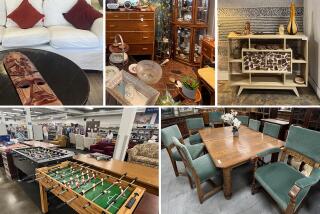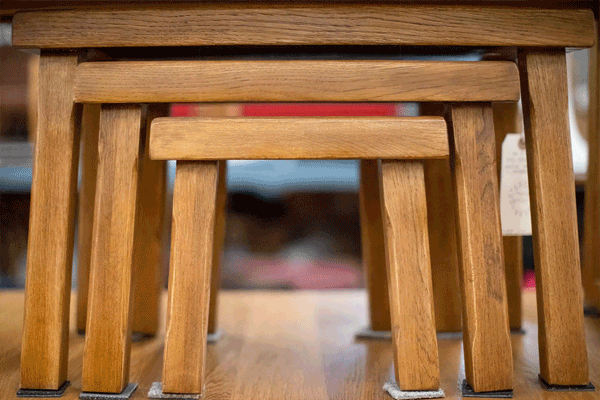FURNISHINGS : Bent Offerings From a Forest of Possibilities
- Share via
If a handful of twigs and branches seems a somewhat unlikely source of material for furniture, think again. The past eight years has seen a big revival in rustic furniture--furniture fashioned from branches, twigs, tree-roots and slabs of wood.
“People can’t get over the fact that this type of furniture is actually comfortable,” says Neil Sears, a rustic furniture craftsman in Lake Elsinore. “It usually follows a pattern. They’ll scrunch up their nose a little, then sit down, and say, ‘Oh, but it is comfortable.’
“People always ask me if I think the twig furniture is enjoyable to sit in. And I’ll say, ‘Yeah, it’s very comfortable, for a bunch of twigs,’ ” he admits. “Let’s face it, it’s not goose-down pillows. But you get something much more earthy and natural, and unique, really unique.”
The woods usually used in creating rustic furniture are the ones that bend well, such as willow, cypress (available in the Southern states), hickory, yellow and white birch, oak maple and red cedar.
Chairs, benches, poster beds, headboards, rocking chairs, side-tables, coffee tables, lamps, just about any piece of furniture can be fashioned in the rustic design. Their look is as unique and idiosyncratic as the trees from which they came.
“The plan lies buried in the wood,” says rustic artist-craftsman Daniel Mack, who works from a studio in Manhattan. “A piece should look as though it’s part of a tree, and just as the tree is still growing, rustic furniture should have the illusion of movement. Also, the authorship should be clear.”
Because it is idiosyncratic in its natural origin, rustic furniture sometimes has more inventiveness and imagination in its design than traditional furniture. Rustic is the only kind of furniture not sculpted or chiseled: parts of trees are joined as in nature; knots and disfigurements remain intact. Forks, roots, burls and gnarled joints are often woven into the design.
No longer the domain of caretakers and carpenters who whittled away the long winter days fashioning the rustic furniture for their resorts, today’s artisans and craftsman are an eclectic breed. Some are mountain men, living without electricity or telephone, others have graduate degrees, leaving behind another profession in search of a more artistic and back-to-nature sphere.
“When I retired 15 years ago, we moved away (from Los Angeles) and up into the clean air,” says Sears. “I wanted something to go along with the change. Making rustic furniture started out as a hobby and now it’s turned into a monster,” he says.
Sears makes what he terms “affordable” rustic furniture: $100 for a chair; $300 for a poster bed. But you can find chairs and beds from $3,000 to $10,000, depending on the artisan.
Jackson Levi Smith, a furniture maker at Sagamore Lodge in New York, has a twig-mosaic table made of split ash and willow twig, set in diamond and other geometric patterns, set atop a base of yellow birch root. Its price: $18,000.
“The personality trait that most usually goes along with rustic furniture is relaxed,” says Wendy Kneedler of Kneedler-Fauchere in the Pacific Design Center in West Hollywood. “Relaxed, warm, comfortable, ‘hey-let’s-put-our-feet-on-the-table’-type person. It’s structurally beautiful, but not ultra-formal and pristine. A lot of people from the artistic arenas, like painters, entertainers, craftspeople, like this style of decor. It’s very distinctive but not flashy and fluffy.”
There are six broad categories in the rustic furniture lexicon--Adirondack, Gothic, Bentwood, Western, Gypsy and factory made.
The rustic style reached its apogee in the Adirondacks in the late 1800s, when William West Durant, the son of the great railroad entrepreneur Thomas Clark Durant, began building Great Camps around Raquette Lake. An Upper Saranac Lake carpenter, Ernest Stowe, emerged as the master craftsman by refining this style, using white birch bark as veneer, and often adding classical elements such as columns and cornices.
Adirondack furniture is the most un-twiglike of all rustic furniture. These pieces are often heavy, geometric and tidy. They fall into two general categories.
First, they’re pieces made of split sticks, roots and burls, applied painstakingly in a mosaic-like fashion over traditional flat-faced furniture. Twigs ornament these pieces to give them a dappled appearance.
The second kind of Adirondack look is made of birch, birchbark and cedar, in a log-type appearance. These are the more formidable and heavy-looking pieces.
Gothic rustic furniture are antiques, dating from 1820 to 1850. Most pieces show a European influence and emphasize the irregular: forks, burls, roots and other natural deformities are highlighted. Gothic rustic furniture was often made of the nearly indestructible rhododendron.
The most popular kind of rustic furniture today is Bentwood, which had its heyday from 1880 to 1940. It’s usually made in mountain areas, especially in Appalachia, and has a romantic and free-form quality (compared to the strict geometry of the carpenter-built Adirondack). Bentwood rustic traces elements from Thornet’s Bentwood Chair of the 1840s.
Gypsy rustic is usually hastily and loosely constructed in willow wood and is less expensive than other rustic furniture.
Indiana saw an outpouring of factory-made rustic furniture in the late 1800s when resort and hotel owners began buying thousands of pieces. The oldest manufacturers, the Old Hickory Chair Co. and the Rustic Hickory Furniture Co., are still producing today. Factory-made pieces often have a lot of weaving on the seats and backsides.
Finding good rustic furniture in Southern California is an adventure, but there are some artisans and design firms around.
Haptor Barrett in the Design Center South in Laguna Niguel carries furniture from the Indiana’s Hickory Chair Co., a pioneer in the field. Hickory has four main groupings and designers from which to choose--America Digest Collection, which is primitive with lots of paint; the Authentic James River Reproductions, a French group that is very traditional, and designer Mark Hampton, whose distinctive style covers French and Victorian styles, and incorporates chintz and fabrics with the woods.
Kneedler-Fauchere is a showroom at the West Hollywood Pacific Design Center and carries several different rustic furniture companies, including Old Hickory Rustic Furniture from Indiana and a Western-style rustic company called Sweetwater Ranch, patterned after Thomas Molesworth’s great designs from Cody, Wyo. Country Life Furniture is recycled Vermont Farmhouse wood fashioned in Topanga Canyon and Farmhouse Country is a more delicate form of rustic design.


